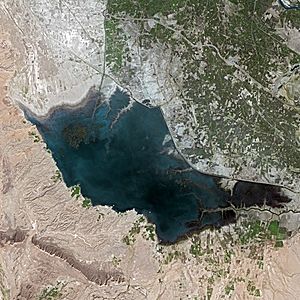Manchar Lake facts for kids
Lake Manchar is the biggest freshwater lake in Pakistan. It is also one of the largest freshwater lakes in all of Asia! You can find it in the Sindh region, west of the Indus River. The lake's size changes throughout the year, from about 350 square kilometers to as much as 520 square kilometers. Water flows into Lake Manchar from many small streams in the Kirthar Mountains. Then, the lake's water flows out into the mighty Indus River.
Contents
What is Lake Manchar?
Lake Manchar is a very important natural feature in Pakistan. It is known for being the largest freshwater lake in the country. It also ranks among the biggest freshwater lakes on the entire continent of Asia. This means its water is not salty, making it useful for many things.
Where is Lake Manchar Located?
This large lake is found in the Sindh province of Pakistan. It sits to the west of the famous Indus River. The Indus River is one of the longest rivers in Asia. Lake Manchar is connected to this river, which is important for its water supply.
How Does Lake Manchar Change Size?
Lake Manchar does not stay the same size all year round. Its area can change a lot with the seasons. During drier times, the lake might shrink to about 350 square kilometers. But when there is more rain, it can grow much larger. It can expand to about 520 square kilometers. This change in size depends on how much water flows into it.
Why is Lake Manchar Important?
Lake Manchar plays a vital role for the local people and the environment. It provides water for farming and drinking. Many people who live near the lake rely on it for their daily lives. The lake also supports a variety of plants and animals. It is a home for many types of fish and birds. This makes it an important place for nature and wildlife.
What Lives in Lake Manchar?
The freshwater of Lake Manchar is a perfect home for many creatures. You can find different kinds of fish swimming in its waters. These fish are a food source for the local communities. The lake also attracts many birds, especially during migration seasons. It is a resting and feeding spot for them. This rich wildlife makes the lake a lively ecosystem.


